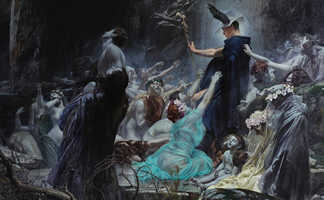Although Poseidon is primarily known as the god of the sea, he also has sovereignty over storms and earthquakes. In addition, he gave man the first horse.
That last one looks a little strange- I mean, we all know he’s the god of the sea, and, by extension, storms, since many storms form over the sea. Earthquakes still fall in the category of natural phenomena, and many occur on the seabed anyway, causing devastating tsunamis. But horses? We’ll get into the back story on horses in a minute, and see how it is that Poseidon gets credit for giving the human race what turned out to be its primary form of rapid overland transport and heavy labor for several thousand years. As an early poem states:
Lord Poseidon, from you this pride is ours, the strong horses, the young horses.
By virtue of its geography as a peninsula with its hundreds of islands scattered across the Aegean, Greeks are and always have been a maritime people. That’s why Poseidon has assumed outsized importance in their daily affairs. Poseidon is said to have been given sovereignty over the seas by virtue of lots drawn between him and his brothers Zeus and Hades after they defeated the Titans. Zeus was given authority over the earth, Hades over the underworld, and Poseidon over the sea.
Known as the “Earth-shaker,” Poseidon was said to have had a magnificent palace on the seabed, but he also spent a fair amount of time hanging around Mt. Olympus. He was never without his chief symbol, the trident, which makes him the most instantly identifiable god in the Greek pantheon in Greek-themed art. Ironically, the most famous image of Poseidon, found in the National Archaeological Museum in Athens, is a magnificent 5th century BC bronze statue of the god in the stance of a javelin thrower, about to cast his trident, but the trident is missing. The trident was his primary weapon, with which he raised storms, caused earthquakes, and generally committed various kinds of Olympian mischief.
As were four of his brothers and sisters, Poseidon was swallowed whole by his father, Cronus, at birth to prevent a prophesied family coup. He was rescued by Zeus, and the brood of six gods went to war against the ruling Titans, eventually overthrowing them in the Titanomachy, which will be the subject of a subsequent blog post. In another, later war, the Gigantomachy, or War Against the Giants, Poseidon crushed the giant Plybotes beneath a massive rock that he had torn off from the island of Kos. The rock became the island of Nisyros.
Poseidon is a very old god in Greek lore, dating from the Bronze Age Mycenaean Civilization (1750-1050 BC). He was a high-ranking Mycenaean deity, said to gift his worshippers with exceptional navigational skills. In the Christian era, Agios Nikolaos, patron saint of sailors (and the same saint that Santa Claus is based on), has taken Poseidon’s place as protector of sailors. Every Greek seaworthy vessel, from the smallest fishing cacique to the largest oil tanker, has an icon of Agios Nikolaos somewhere on board.
Poseidon and Athena both desired to be the patron of Athens. Apparently the Olympians did a fair amount of this sort of thing; vying with one another to be the patron of a city or region.
Zeus decreed a contest between the two deities, which took place on the Acropolis: each was to offer the city a gift. Athena gave the city the olive tree. Poseidon struck the rock of the Acropolis with his trident and brought forth seawater. Obviously Athena would win this contest hands down. One version of the story goes that Poseidon, undeterred, figured he’d try again and get it right this time. And he did. He struck the earth and out of sprung, fully formed, the world’s first horse, with a wavy mane resembling the sea. This proved his ingeniousness as a creator, and explains why he is often portrayed as driving a chariot over land, or a chariot being drawn by seahorses over the ocean.
At any rate, this didn’t change anything. Athena was still the winner of the contest. She became the patroness of Athens, which named itself after her, and earned her the permanent enmity of Poseidon. From that time they were forever in conflict. During the Trojan war, for example, Poseidon sided with the Achaeans (Greeks) and Athena took the side of the Trojans.
Poseidon, like Zeus, was something of a ladies’ man. And, in some cases, a “man’s” man. And as it was with Zeus, these relationships were both consensual and non-consensual. He also, like his brother, fancied both mortals and non-mortals.
He took a liking to his sister, Demeter, goddess of agriculture, as she was mourning the loss of her daughter, Persephone, to another of her brothers, Hades. Demeter cleverly took evasive action by transforming herself into a mare and hiding in the herd belonging to King Onkios, a ruler in Arcadia in the central Peloponnese. This didn’t fool Poseidon for a minute. He simply changed himself into a stallion and had his way with her.
The product of their union was Despoina, who wound up being worshipped with her mother Demeter in the Eleusinian Mysteries. “Despoina” was not her actual name. “Despoina” comes from “despot,” ruler, and is properly understood as the mistress (as opposed to the male version, “master.” Her real name was kept secret and only initiates in the Mysteries had access to her real name, which was lost with the religion.
Other versions of this myth has the daughter of Poseidon and Demeter being Persephone herself. The other offspring of their union was the mythical, lightning-quick, black horse Arion, who was eventually given to Heracles.
Poseidon had a number of other interesting offspring by various girlfriends, such as the Cyclops Polyphemus (“very famous”) by the sea nymph Thoosa. This was the same Cyclops who imprisoned Odysseus in his cave and was blinded by Odysseus. There were other Cyclopes, but this was the most famous.
He is also credited as the father of the hero Theseus, by the mortal princess Aethra (other myths have King Aegeus of Athens as the father), of Orion by Euryale, daughter of King Minos of Crete, and of Pegasus, by Medusa. In the modern day children’s book series Percy Jackson and the Olympians, Percy is said to be the son of Poseidon.
Plants and animals associated with Poseidon include the bull, the horse, the dolphin, all fish, the Cretan bull (sire of the Minotaur), the pine tree, and wild celery (which was fashioned into a wreath and was used to crown the victors in the Isthmian Games).




















